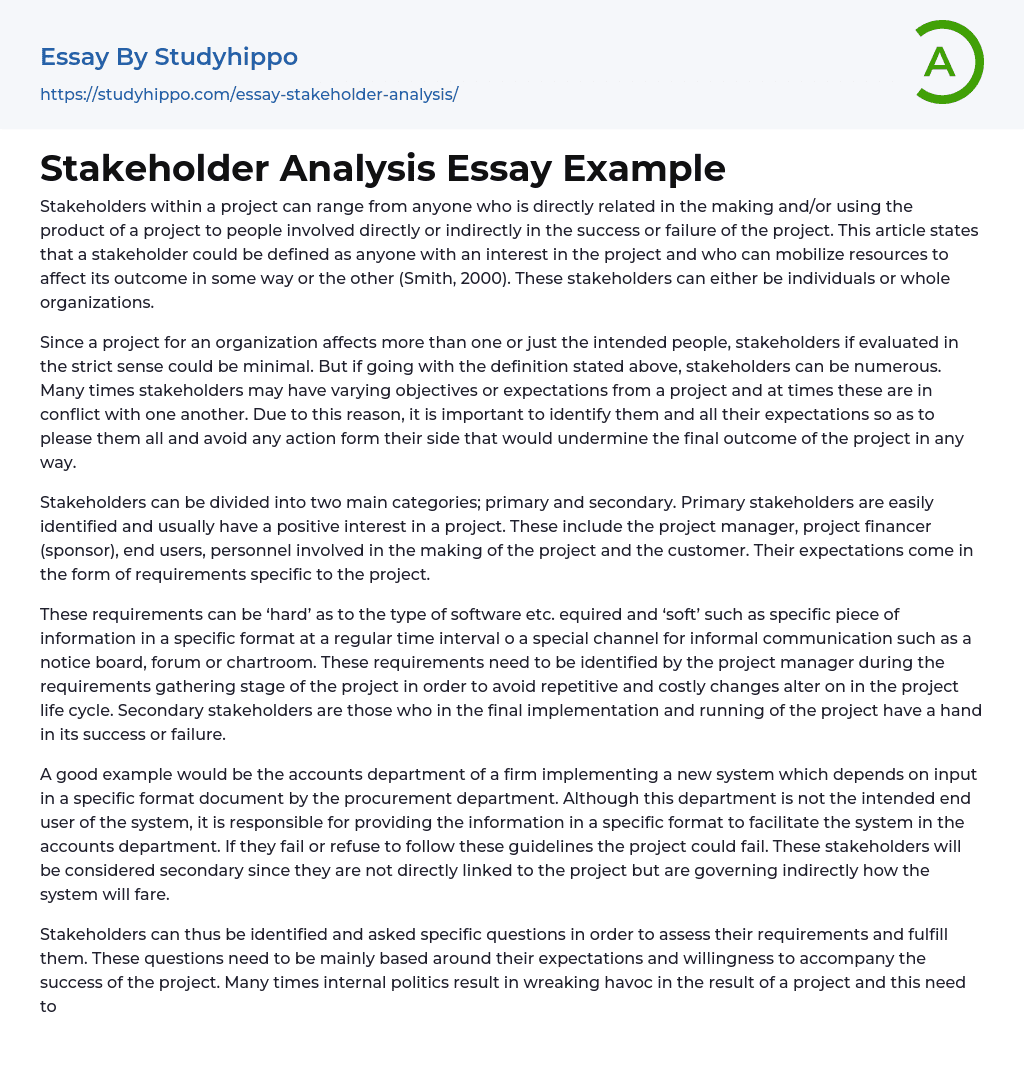Stakeholders within a project can range from anyone who is directly related in the making and/or using the product of a project to people involved directly or indirectly in the success or failure of the project. This article states that a stakeholder could be defined as anyone with an interest in the project and who can mobilize resources to affect its outcome in some way or the other (Smith, 2000). These stakeholders can either be individuals or whole organizations.
Since a project for an organization affects more than one or just the intended people, stakeholders if evaluated in the strict sense could be minimal. But if going with the definition stated above, stakeholders can be numerous. Many times stakeholders may have varying objectives or expectations from a project and at times these are in conflict with one another. Due to th
...is reason, it is important to identify them and all their expectations so as to please them all and avoid any action form their side that would undermine the final outcome of the project in any way.
Stakeholders can be divided into two main categories; primary and secondary. Primary stakeholders are easily identified and usually have a positive interest in a project. These include the project manager, project financer (sponsor), end users, personnel involved in the making of the project and the customer. Their expectations come in the form of requirements specific to the project.
These requirements can be ‘hard’ as to the type of software etc. equired and ‘soft’ such as specific piece of information in a specific format at a regular time interval o a special channel for informal communication such as a notice board, foru
or chartroom. These requirements need to be identified by the project manager during the requirements gathering stage of the project in order to avoid repetitive and costly changes alter on in the project life cycle. Secondary stakeholders are those who in the final implementation and running of the project have a hand in its success or failure.
A good example would be the accounts department of a firm implementing a new system which depends on input in a specific format document by the procurement department. Although this department is not the intended end user of the system, it is responsible for providing the information in a specific format to facilitate the system in the accounts department. If they fail or refuse to follow these guidelines the project could fail. These stakeholders will be considered secondary since they are not directly linked to the project but are governing indirectly how the system will fare.
Stakeholders can thus be identified and asked specific questions in order to assess their requirements and fulfill them. These questions need to be mainly based around their expectations and willingness to accompany the success of the project. Many times internal politics result in wreaking havoc in the result of a project and this need to be avoided at all costs. Assessing and then avoiding such circumstances are the project mangers responsibility which can be addressed through the impact and time approach.
This approach tells of how far fetched a stakeholder’s impact would be on the project and at what time it could be encountered in the project lifecycle. These can then be treated at risks and averted or diluted through various means. In the end
the whole process can be divided into five steps of identifying stakeholders, identifying their expectations, assessing their influence, risks involved and participation in the project (Smith, 2000).
- Chief Executive Officer essays
- Convenience Store essays
- Firm essays
- Training And Development essays
- Unilever essays
- Variable Cost essays
- Virgin Group essays
- Bargaining essays
- Entity essays
- Pest analysis essays
- John Locke essays
- 9/11 essays
- A Good Teacher essays
- A Healthy Diet essays
- A Modest Proposal essays
- A&P essays
- Academic Achievement essays
- Achievement essays
- Achieving goals essays
- Admission essays
- Advantages And Disadvantages Of Internet essays
- Alcoholic drinks essays
- Ammonia essays
- Analytical essays
- Ancient Olympic Games essays
- APA essays
- Arabian Peninsula essays
- Argument essays
- Argumentative essays
- Art essays
- Atlantic Ocean essays
- Auto-ethnography essays
- Autobiography essays
- Ballad essays
- Batman essays
- Binge Eating essays
- Black Power Movement essays
- Blogger essays
- Body Mass Index essays
- Book I Want a Wife essays
- Boycott essays
- Breastfeeding essays
- Bulimia Nervosa essays
- Business essays
- Business Process essays
- Canterbury essays
- Carbonate essays
- Catalina de Erauso essays
- Cause and Effect essays
- Cesar Chavez essays




